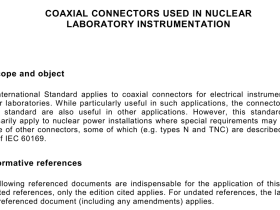IEC 60691:2002 pdf download

IEC 60691:2002 pdf download.Thermal-links – Requirements and application guide
Replace, on page 43, the existing item g) by the following new item g): g) Compliance is checked by the following test. For thermal-links rated 249 °C or lower, the sample shall be placed in a test oven, stabilized at a temperature of T f – 12 K or as declared by the manufacturer, but not higher than 2 K below the lowest tolerance. For thermal-links rated at 250 °C or higher, and a tolerance of T f 0 20 − , the sample shall be placed in a test oven, stabilized at a temperature of T f – 22 K, or as declared by the manufacturer, but not higher than 2 K below the lowest tolerance. The temperature of the oven shall then re-stabilize. All thermal links, rated 249 °C or lower, and 250 °C or higher, shall then be energized and the oven temperature increased at the rate of (2 ± 1) K/min and the test shall be continued until the thermal-link functions or the oven temperature reaches 30 K above T f . NOTE 1 The thermal-link may operate immediately after being energized, in which case the temperature increase of (2 + 1) K is not necessary and the test may be stopped. Add the following new note at the end of 10.6.2: NOTE 2 The main purpose of this test is to evaluate the mechanical and electrical integrity of the thermal-link to interrupt a certain load.
11.2 Rated functioning temperature, T f
Replace the existing subclause by the following: Thermal-links shall be exposed, in the test oven or oil bath, to T f – 12 K or as declared by the manufacturer but not higher than 2 K below the lowest tolerance for devices rated less than 250 °C, until the temperature has stabilized shown when two consecutive readings taken 5 min apart are within 1 K of each other. For devices rated 250 °C or higher, the thermal-links shall be exposed to T f – 22 K, or as declared by the manufacturer, but not higher than 2 K below the lowest tolerance. The temperature shall then be stabilized, shown when two consecutive readings taken 5 min apart are within 1 K of each other. The temperature shall then be increased steadily with a rate of rise between 0,5 K/min to 1 K/min, until all specimens have functioned. The individual functioning temperature of thermal-links, rated less than 250 °C, shall be recorded and they shall be not less than as declared by the manufacturer, or T f – 10 K if no declaration is made. For thermal-links rated at 250 °C or higher, the recorded temperature shall be not less than that declared by the manufacturer, or T f – 20 K if no declaration is made. For thermal-links rated lower than 250 °C, or higher than 250 °C, the temperature shall not be greater than T f . NOTE The equipment recommended for the tests of 11.2 is shown in Clause C.6.
13 Manufacturer’s validation programme
The manufacturer shall conduct regular inspections for production control and tests for validating performance per 13.1 and 13.2. 13.1 The manufacturer shall test three samples each, for all temperature ratings for thermal- links, once every two years for 10.6 (Interrupting current), 11.2 (Rated functioning temperature) and 11.3 (Maximum temperature limit) followed by the tests of 10.3 (Dielectric strength) and 10.4 (Insulation resistance). The pre-conditioning tests of Clause 9 (Mechanical requirements) may be omitted. 13.2 The tests of 10.6 shall be conducted on a) the highest voltage rating, b) the highest current rating, c) both a) and b) on the resistive and inductive ratings. Non-compliance in any of the tests shall be subject to a review and repetition as per Clause 5.









